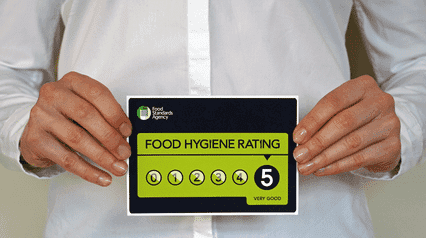What is Food Hygiene Rating?
A food hygiene rating system is a way of assessing and scoring the hygiene standards of a food business. The ratings are based on an inspection of the premises, the process of food handling and preparation, and the overall systems involved in its food operations. Typically, the rating system uses a range of 0-5, with 0 being the lowest and 5 being the highest.
Who Uses It?
Food hygiene rating is a useful tool for anyone involved in the food industry. This includes restaurants, cafes, takeaways, caterers, food manufacturers, and food retailers. It’s also beneficial for those who are responsible for the safety and quality of food, such as food safety officers, health inspectors, and food safety consultants.
Consumers can also treat the food hygiene rating scheme as an important tool as it helps them identify the food establishments that have the highest standards of food hygiene. This is crucial when they’re making informed decisions about where to eat or buy food due to the established credibility of such food shops.
On the other hand, local authorities use this rating scheme in determining establishments that fail to comply with the required food hygiene standards. This way, they can take action to ensure that food safety is maintained in their area.
Why Use the Food Hygiene Rating System?
Improved Consumer Safety
The primary benefit of a food hygiene rating is that it helps ensure the safety of the public when they purchase and consume food products. By providing a rating system, consumers can make informed decisions about where to buy food and be confident that the food they are consuming is safe. It also contributes to reducing the risk of foodborne illnesses.
Increased Transparency in the Food Industry
A food hygiene rating scheme also helps protect businesses, as they provide an incentive for businesses to maintain high standards of food safety, thus being held accountable for their overall operations.
Favorable Business-to-Business (B2B) Relations
Having a good food hygiene rating also helps businesses in the food industry establish their credibility in the market as trusted suppliers and partners for other businesses as well. Hence, B2B relationships can be improved through the use of a food hygiene rating scheme, which serves as a high-level standard for competent and trusted food industry players.
The Food Hygiene Rating Scheme and How It Works
Food hygiene ratings are typically determined by local authorities such as the Food Standards Agency in the UK.
Food Hygiene Rating Scheme (FHRS)
The most common type of food hygiene rating is the Food Hygiene Rating Scheme (FHRS), which is currently being adopted by England and Wales. This scheme is based on a scale of 0 to 5. As a food business acquires higher points from the inspection, its rating becomes lower because the inspector bases it on the number of issues they find concerning the food business’s food hygiene practices.
As a guide, here’s a quick overview of how the rating scheme works and the corresponding points per rating:
- Food hygiene rating 5: Very Good (0-15 points) – a food business displays and practices excellent hygiene standards on its premises
- Food hygiene rating 4: Good (20 points) – there are a few areas for improvement
- Food hygiene rating 3: Generally Satisfactory (25-30 points) – there is room for improvement, but these areas don’t generally pose immediate health risks
- Food hygiene rating 2: Improvement Necessary (35-40 points) –
- Food hygiene rating 1: Major Improvement Necessary (45-50 points) – there are a few areas needing immediate attention
- Food hygiene rating 0: Urgent Improvement Necessary (50+ points) – there are significant food hygiene issues that can put public health at risk
Food Hygiene Information Scheme (FHIS)
Another type of food hygiene rating is the Food Hygiene Information Scheme (FHIS). This scheme is used in Scotland and Northern Ireland and is based on a scale of 0 to 4. The ratings are determined by local authorities such as the Food Safety Authority of Ireland.
When looking at a food hygiene rating, it’s important to consider the overall score, as well as the individual criteria that were used to determine the rating. For example, a rating of 4 may indicate that the establishment has met all of the criteria but may have scored lower in one or two aspects. Also, the context of the rating must be looked at. For instance, a rating of 4 may be considered good in one location but may be considered poor in another.
Tips on How to Improve Food Hygiene Ratings
Improving food hygiene ratings is an essential part of running a successful food business. There are several steps that can be taken to ensure that food hygiene ratings are improved.
Training
The first step is to ensure that all staff is properly trained in food hygiene and safety. This includes ensuring that all staff is aware of the importance of following food safety regulations and that they understand the risks associated with not following them. Additionally, staff should be trained in the proper handling and storage of food, as well as the proper cleaning and sanitizing of equipment and surfaces.
Food Storage and Preparation
The second step is to ensure that all food is stored and prepared in a safe and hygienic manner. This includes ensuring that all food is stored at the correct temperature, that all surfaces and equipment are kept clean and sanitized, and that all food is cooked thoroughly.
To help streamline this crucial stage in maintaining food hygiene standards (e.g. Codex Alimentarius), using a food safety checklist is a must in ensuring that all aspects of the operations are checked and completed.
Create Your Own Food Hygiene Audit Checklist
Eliminate manual tasks and streamline your operations.
Get started for FREELabeling and Disposal
Additionally, you must ensure that all food is labeled correctly for various reasons. These include:
- effectively recording their expiration dates and improving your inventory management system;
- knowing what kind of storage each kind of food or ingredient needs to keep its quality; and
- helping consumers be properly informed about what they’re purchasing.
Lastly, your organization must have a working system in ensuring all food waste is disposed of properly. This also helps improve your food hygiene practices.
Regulations and Guidelines
It’s crucial for food establishments to be aware of the regulations and guidelines in their country and to ensure that they are following them. This helps ensure that the food they serve is safe and of high quality.
The regulations and guidelines for food hygiene ratings vary from country to country. In the United States, the Food and Drug Administration (FDA) is responsible for setting the standards for food safety and hygiene. The FDA has established the Food Code, which is a set of regulations that must be followed by food establishments. The Food Code covers topics such as food storage, preparation, and handling, as well as sanitation and hygiene.
In the UK, the FSA is responsible for setting the standards for food hygiene rating and providing information on how to interpret them. The FSA has established the FHRS, a system that assigns ratings to food establishments based on their compliance with food hygiene regulations. The FHRS website is a resource where you can find food hygiene ratings for restaurants, takeaways, and other food businesses in England and Wales. For Scotland and Northern Ireland, the FHIS applies.
In addition to the regulations and guidelines set by the FDA and FSA, many countries have their own food safety and hygiene regulations. Such are as follows:
- Food Hygiene Policy in the European Union (EU)
- Food Safety Rating Scheme for Businesses in South Australia
Another useful resource is the Chartered Institute of Environmental Health (CIEH). The CIEH is a professional body for environmental health practitioners. They provide training and qualifications in food hygiene and safety, as well as advice and guidance on food hygiene ratings.
FAQs About Food Hygiene Rating
Food businesses situated in Wales and Northern Ireland are required by law to have their food hygiene ratings displayed on prominent areas of their premises, either on the front door or window. Those in England and Scotland, however, are only encouraged and not required.
Depending on the risk level of food businesses, the time period between inspections may vary, which can also affect the validity duration of a food business’s hygiene rating. In most cases, the following is the ideal time period between each inspection:
- High-risk businesses – six months
- Low-risk businesses – two or more years
Since food hygiene rating is more popular in the UK, the countries that recognize it are England, Scotland, Northern Ireland, and Wales. As mentioned above, food businesses in Wales or Northern Ireland are required to display their food hygiene rating score on their premises. On the other hand, those in England and Scotland are only encouraged.
A food business with a food hygiene rating 1 should make urgent or major improvements to its current hygiene practices. An organization’s food safety officer must be responsible for coordinating the changes needed to be made and ensuring improvements are aligned with the recommendations of the Environmental Health Officer (EHO) who conducted the inspection.




